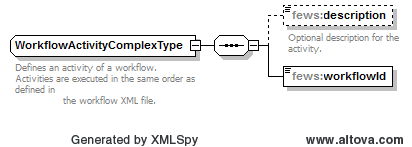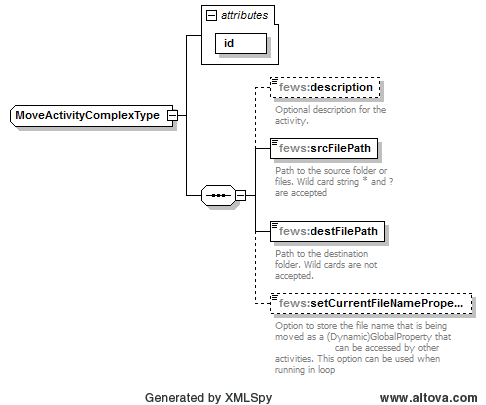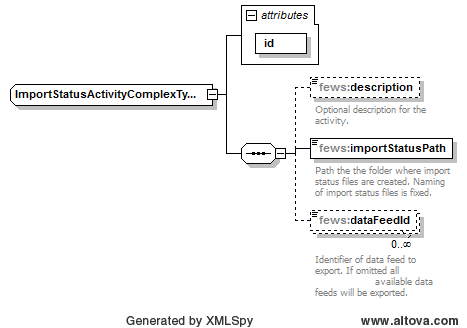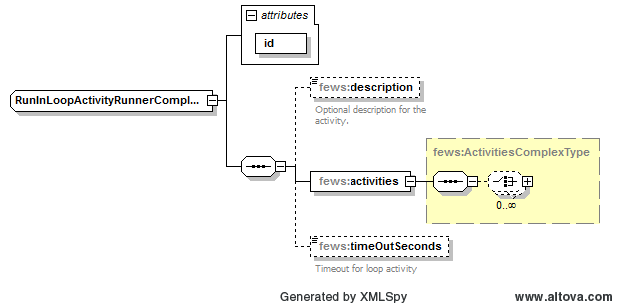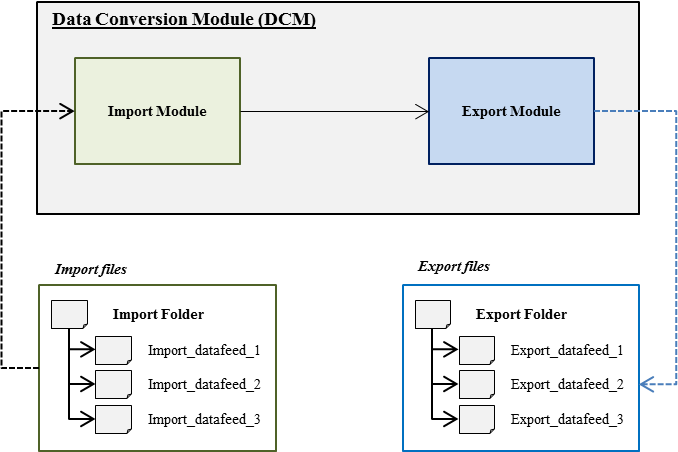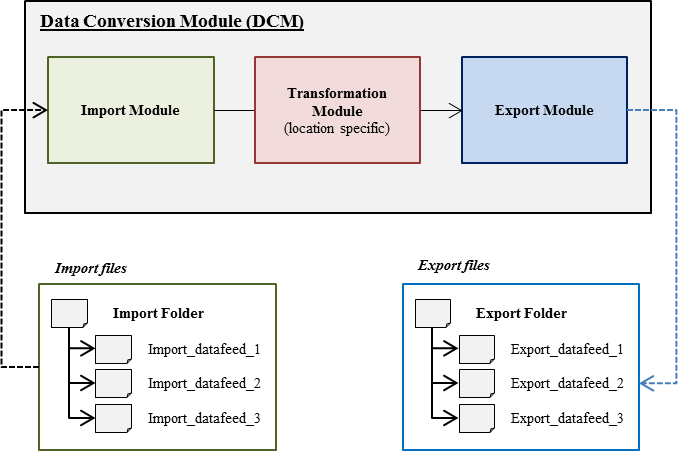...
| Code Block | ||
|---|---|---|
| ||
<runInLoopActivityRunner id="runInLoop">
<activities>
<!— This CopyActivity will copy all XML files form the Import/aquo directory. However because
The activity is being run in a loop each file will be copied individually. By setting the property 'setCurrentFileNameProperty' the name of the file being copied will be mapped to the key CURRENT_FILENAME. This key can then be used by the other activities as shown below. -->
<copyActivity id="loopedCopy">
<srcFilePath>%REGION_HOME%/TestData/Import/aquo/*.xml</srcFilePath>
<destFilePath>$IMPORT_FOLDER_ROOT$/aquo/</destFilePath>
<setCurrentFileNameProperty>CURRENT_FILENAME</setCurrentFileNameProperty>
</copyActivity>
<moveActivity id="loopedMove">
<srcFilePath>$EXPORT_FOLDER_ROOT $/aquo/*</srcFilePath>
<destFilePath>$BACKUP_FOLDER_ROOT$/aquo/$CURRENT_FILENAME$.xml</destFilePath>
</moveActivity>
...
|
Figuur Figure 6 DataConversion copy activity
...
- description: optional information
- workflowId: id of workflow to be run
Figuur Figure 7 DataConversion workflow activity
...
- id: required idendifier.
- description: optional information
- srcFilePath: path to files that are to be copied. Wildcards accepted.
- destFilePath: path to destination directory. No wildcards allowed.
- setCurrentFileNameProperty: option that sets the name of the file currently being moved as a global property. This property can then be accessed by other activities. This option only works when this activity is nested in a ‘runInLoopActivityRunner’ activity.
Figuur Figure 8 DataConversion move activity
...
- id: required idendifier.
- description: optional information
- importStatusPath: path to the directory in which status file is to be generated.
- dataFeedId: option to filter the ‘dataFeedId’ values that are to be exported to file. If omitted all available datafeed information will be exported.
Figuur Figure 9 DataConversion import status
...
- id: required idendifier
- description: optional information
- activities: list of activities over which to loop
- timeOutSeconds: option timeout in seconds after which looping is terminated.
Figuur Figure 10 DataConversion run in loop activity
...
Configuration of DCM: conversion task variants
Variant 1: Import, Export.
Figure 11 Simplest workflow variant in DCM. The DCM is only used for conversion of the file format, there is no need for transformations.
Note (1): If you need to use LocationSets.xml for transformations than it is also necessary to add a Locations.xml to your Config/RegionConfigFiles folder.
Note (2): If you need to use IdMapping or Unitconversion than it is necessary to add a Parameters.xml to your Config/RegionConfigFiles folder.
| Code Block | ||
|---|---|---|
| ||
<?xml version="1.0" encoding="UTF-8"?>
<timeSeriesImportRun xmlns="http://www.wldelft.nl/fews" xmlns:xsi="http://www.w3.org/2001/XMLSchema-instance" xsi:schemaLocation="http://www.wldelft.nl/fews http://fews.wldelft.nl/schemas/version1.0/timeSeriesImportRun.xsd">
<import>
<general>
<importType>LmwWeatherdata</importType>
<folder>$IMPORT_FOLDER_ROOT$/LMW_maasaa</folder>
<idMapId>IdImport_LMWmaasaa</idMapId>
</general>
<temporary>true</temporary>
</import>
</timeSeriesImportRun>
|
| Code Block | ||
|---|---|---|
| ||
<timeSeriesExportRun xmlns="http://www.wldelft.nl/fews" xmlns:xsi="http://www.w3.org/2001/XMLSchema-instance" xsi:schemaLocation="http://www.wldelft.nl/fews
http://fews.wldelft.nl/schemas/version1.0/timeSeriesExportRun.xsd">
<export>
<general>
<exportType>NETCDF-CF_TIMESERIES</exportType>
<folder>$EXPORT_FOLDER_ROOT$/LMW_maasaa</folder>
<exportFileName>
<name>_LMWmaasaa.nc</name>
<prefix>
<timeZeroFormattingString>yyyy-MM-dd'T'HHmmss</timeZeroFormattingString>
</prefix>
</exportFileName>
<unitConversionsId>ExportUnitConversions</unitConversionsId>
<exportMissingValueString>-9999.0</exportMissingValueString>
<exportTimeZone>
<timeZoneOffset>+01:00</timeZoneOffset>
</exportTimeZone>
</general>
<properties>
<bool value="false" key="includeFlags"/>
<bool value="false" key="includeComments"/>
</properties>
<metadata>
<title>Export of LMW_maasaa datafeed</title>
<institution>Deltares</institution>
<history>Exported at time zero = %TIME_ZERO(yyyy/MM/dd HH:mm:ss z)% in module instance %MODULE_INSTANCE_ID% as part of workflow %WORKFLOW_NAME% by user %USER_ID%.</history>
<comment>The actual time of writing was %CURRENT_TIME(yyyy-MM-dd HH:mm:ss z)%</comment>
</metadata>
</export>
</timeSeriesExportRun> |
Variant 2: Import, Transformation, Export.
Figure 12 Using Transformation functionality to change timeseries.
Variant 3: Import, (dis)Aggregation, Export.
Figure 13 This construction is needed whenever functionalities are used that need data from previous DCM runs. The extra export/import routine ensures that the user has data from previous DCM runs.
Run the DCM
The DCM can be executed as a script from the command line or as a scheduled task (see Figure 2 for the location of these files).
...

